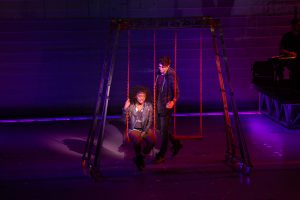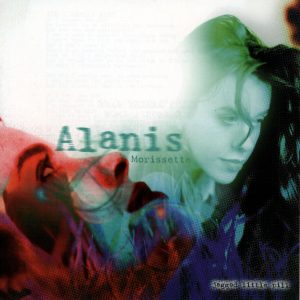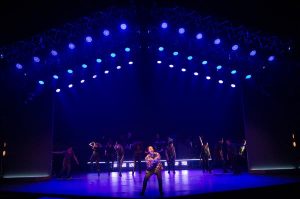Jagged Little Pill is the newest show to hit the Great White Way (opens December 5th), and it is also one of the many jukebox musicals opening this season. To mix things up for a change this is not a bio-musical about Alanis Morissette, no this show features an original book to accompany the songs from her album. The songs from the titular album are known to be powerballads filled with emotion. So the question I had going into this show was; can Diablo Cody, academy award winning writer of Juno, conjure up a plot to house these songs? And can the show create a healthy balance between he plot and the songs? Or will they overdose?

As the title of this review suggests this musical tries to cram in a lot of story into a 2 hour and 40 minute long show. To summarize the plot therefore is going to be a big task but I’ll try anyway. The show starts and ends with a Christmas letter that gets written by the mother of a suburban Connecticut family Mary Jane Healy (Elizabeth Stanley), in between these letters we see a year in the life of the Healy family unfold. Son Nick (Derek Klena) just got into Harvard, father Steve (Sean Allan Krill) is a workaholic who barely sees his family and daughter Frankie (Celia Rose Gooding) feels estranged from her family because she is adopted and feels as though she is being pressured into a white mold whilst being a black girl. If this seems like a lot to unpack already then buckle up because this is what we learn about the characters in the first 10 minutes already. During the first half of the first act we also find out that Frankie is in a kinda-sorta relationship with a lesbian girl at school called ‘Jo’ (Lauren Patten), who gets into trouble at home because her mother is a devout Christian. Frankie however falls in love with a boy from her poetry class who has to take care of his disabled sister. Both Frankie and Nick are at a party in the same first half of the first act at which Nick witnesses the rape of his friend Bella (Kathryn Gallagher) and at the same time we see Mary Jane spiraling downwards in her depression and resorting to drugs.
To say there’s a lot of story is an understatement. If we break down this story into the classic dramatic structure we can see that they use up most of the first act with world building, the inciting incident is the rape but the real conflict; being that the mother recognizes herself in the situation but doesn’t want to admit it, only gets introduced with the act 1 finale. Because the first act is basically ‘set-up the musical’ the second act runs a lot smoother, even though it still introduces more problems and character-elements than the story can handle. At least, because we now know the conflict, the show is ramping up to something.

Jukebox musicals are always tricky to pull-off successfully. You basically have 2 realistic options to choose from: bio-musical or original story. If you take the latter route you have to create a story in which the songs make sense either narratively or emotionally. Had they been working from a concept-album, like Hadestown and Wrong Man did, it would have been easier, because the creator generally already has a story or theme in mind. Jagged Little Pill, the album, however contains so many different themes and stories which makes it incredibly to weave them together with a plot to create a cohesive story. And it shows. Lauren Patten’s ‘Jo’ gets the honour of belting out the immensely powerful ‘Oughta Know’ during the second act, a song that got a standing ovation, but afterwards you start to think: did this character earn this moment? She does, ultimately, but you do hesitate because her character arc just gets drowned out by the many other character arcs. Another problem the songs represent is the fact that they’re rocknumbers, creatively you’d have to ask yourself if you would want to change the intensity or the style of the songs to fit your story and in this case they have not changed them. This makes it particularly hard to understand some songs that are sung by characters who are clearly more comfortable with singing in a more classic Broadway style. Which is a strange problem to arise especially considering Tom Kitt is involved in the orchestrations and arrangements, he is most known for a very similar production for which he won a lot of awards: Next to Normal.
Sometimes during the show, for fun presumably, two set-elements carrying the band come in from the wings, they play for a bit and then they disappear again.
The set of the show is as dynamic as the over-abundant choreography, using multiple moving elements the scenes shift in an instant. The most confusing part of this is the band. Sometimes during the show, for fun presumably, two set-elements carrying the band come in from the wings, they play for a bit and then they disappear again. This serve no narrative purpose and even dramaturgically it is confusing as the meta-theatricality adds nothing to the message of the show. Lucy Mackinnon, who did the video and projection design for the show, must have had some busy workdays with Riccardo Hernández the scenic designer. A lot of moving set elements are moving panes that either fly in from above or get moved from side to side. These all have some form of projection-mapping on them as a lot of the projections move in with them or shift whilst they are moving. As the shifting of the scenes is so dynamic we sometimes see the projections move and it takes us out of it for a moment. Moreover, the projection design is often-times a lot more suggestive than the actual set which creates a confusing mix between the reality of the props and furniture and the imagery of the projections. This is however mostly a problem during the first act in which a lot of physical sets get used as opposed to the more suggestive nature of the second act where the projections carry more meaning.

One of the only things about this show that wasn’t either confusing or too much of a good/bad thing were the performances of the actors. There’s a reason Lauren Patten got a standing ovation even though the character moment maybe wasn’t quite set-up right. Her performance as ‘Jo’ is relatable yet cooky and becomes real at just the right moments. This is generally true about all the performances, highlights being Elizabeth Stanley and Kathryn Gallagher who have to portray the stress of past and current trauma. When they are not battling the confused and convoluted book of the show each character gets a moment to shine. Celia Rose Gooding has a powerful scene when Frankie finally opens up to her parents and Derek Klena beautifully portrays the climax of his struggle over the whole rape-plot in a scene that leads into one of the most powerful songs of the evening: ‘no.’
In the end I’m a bit disappointed that this is the show they are presenting in the last week of previews. With all the talent involved, the interesting character arcs and the powerful stories you can see that there is a good show in there but it can’t quite come out. I would describe it as if someone tried to fill in the answers of one crossword into the blanks of another crossword. Sure sometimes a word might fit but some don’t, and you just know that the answers are right but you just haven’t found the right place to put ‘em. This show opens in a week and I hope they haven’t frozen the production yet because it still needs some work.
Seen on: 11/28/2019, seen at the Broadhurst Theatre New York,Lyrics by Alanis Morissette, Music by Alanis Morissette & Glen Ballard, Book by Diablo Cody, Music Supervisor, Orchestrator & Arranger by Tom Kitt, Director Diane Paulus, Production Stage Manager Ira Mont, Stage Manager Jennifer Rogers, Assistant Stage Manager Taylor Brennan, Choreography by Sidi Larbi Cherkaoui, Scenic design by Tony nominee Riccardo Hernández, Costume design by Emily Rebholz, Lighting design by Justin Townsend, Sound design by Jonathan Deans, and projection and video design by Lucy Mackinnon.


